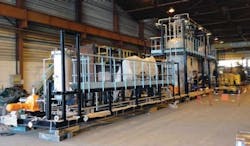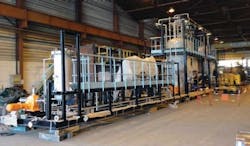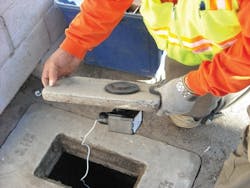Works Begins on Advanced Water Treatment Facility
By Jeannine Larabee and Hossein Ashktorab
To ensure an adequate and reliable supply of high-quality water for the region, the Santa Clara Valley Water District, located in San José, CA, has partnered with cities and water retailers in the county to develop recycled water supplies. In March 2010, the Santa Clara Valley Water District and the City of San José signed a 40-year agreement to build the new Advanced Water Treatment facility (AWTF) and increase the use of recycled water in Santa Clara County. A groundbreaking ceremony for the facility was held in October.
The new state-of-the-art water treatment operation will use three advanced water treatment technologies to produce highly purified water. The AWTF will have the treatment capacity for 10 mgd microfiltration (MF), 8-mgd reverse osmosis (RO), and 10-mgd ultraviolet light disinfection (UV). This water will be blended with the tertiary-treated water already being produced by the San Jose/Santa Clara Water Pollution Control Plant (WPCP) and distributed by the South Bay Water Recycling (SBWR) program to Milpitas, Santa Clara, and San José.
The AWTF is expected to provide the district and the city with multiple benefits:
- Increased reliability of recycled water supply
- Improved recycled water quality to increase its marketability
- Increased SBWR recycled water treatment capacity
- Greater public acceptance of recycled water
- Maximized water reuse alternatives
- Reduced discharges of treated effluent into San Francisco Bay, thus helping to preserve saltwater tidal habitat
- Increased operational flexibility and capacity to the existing tertiary filters at the WPCP during winter months
Background
The Santa Clara Valley Water District has managed the county's water resources for over 80 years. The primary sources of water supply are local water (surface water and groundwater) and imported water, supplied via the San Francisco Bay-Sacramento/San Joaquin Delta. During the past 80 years, the population of the county has increased to approximately 1.8 million residents and the commuter population has increased to approximately 200,000 people working within the county.
About four percent of the county's total water use currently consists of recycled water, primarily limited to landscaping and industrial uses. Santa Clara County used about 16,000 acre-feet of recycled water in 2009 and has used about 118,000 acre-feet of recycled water since 1998. More recently, regulatory decisions and drought conditions have made imported water an increasingly uncertain supply, emphasizing the importance of having local and reliable water supplies, such as recycled water.
The primary objective of the AWTF is to reduce total dissolved solids, silica, organics, and other undesirable constituents such as contaminants of emerging concern. RO currently is the best available technology for removal of dissolved constituents. Water treated by RO can be blended with tertiary effluent from the WPCP to reduce the concentrations of these constituents and to improve the overall quality of recycled water.
The presence of foulants, such as particulate or suspended solids, could adversely affect performance of the RO membrane. Since the mid 1990s, microfiltration has become the industry standard practice for pretreatment of RO feed in wastewater applications because of its ability to consistently provide a near-absolute barrier to particulate material. UV disinfection will be provided at the AWTF to fulfill Title 22 disinfection requirements (California Code of Regulations) for recycled water.
Operation of the AWTF
Two different strategies were developed to provide additional flexibility for the South Bay Water Recycling system and to increase the tertiary filter capacity at the WPCP during winter periods. The summer period is defined from May through November and the winter period from December through April.
Summer Operation
Under the summer operation mode, nitrified secondary effluent from the WPCP will be conveyed to the AWTF where it will be pretreated by MF, then demineralized through the RO process, and disinfected through UV disinfection. The product water will be stored in a 2.25 million gallon storage tank and flow-paced, using a flow control valve, to the SBWR Transmission Pump Station to blend with WPCP tertiary effluent.
Winter Operation
The AWTF will be able to meet the low recycled water demand during the winter period without blending WPCP tertiary effluent. It also will be capable of generally meeting a lower SBWR TDS goal of 400 mg/L. This would increase the tertiary filter capacity at the WPCP during winter periods. The initial AWTF treatment capacities alone may not be sufficient to meet projected maximum day winter demands for year 2015 and 2020. If so, tertiary effluent from the WPCP would supplement flows from the AWTF.
Estimated Cost
The current construction cost is $42.38 million plus the value of the land owned by the WPCP, which is leased to the district for $10/year. In April 2007, the California Department of Water Resources awarded an approximately $3 million state grant to this project. In addition, the district and the city recently received an additional $8.25 million in federal funding through the American Recovery and Reinvestment Act, administered by the United States Bureau of Reclamation.
Indirect Potable Reuse
In the long term, the district is investigating the possibility of using highly purified recycled water for replenishment of groundwater basins. Salinity reduction is a key step if the district decides to pursue that course. Recycled water can be expanded to many additional uses by reducing the salinity to 500 ppm but groundwater recharge requires much lower salinity, in the range of 30-50 ppm. The district will conduct a feasibility study, and various research studies, before making a decision. This district effort, which will invite stakeholder and community input, will likely be completed by 2016.
The AWTF will employ technology similar to that currently being used by the Orange County Water District's Groundwater Replenishment Project, which has spent years demonstrating the reliability and safety of advanced treatment and is already recharging groundwater basins with advance-treated recycled water.
The lead time for implementing a groundwater recharge reuse project is approximately 10 to 15 years. Similar projects across the world, including Singapore's NEWater and Perth, Australia's latest reservoir augmentation project, show that gaining public acceptance takes many years and is the key to successful projects. Construction of the AWTF in Santa Clara County now will work toward developing this public trust and acceptance by providing a high-quality, reliable, and local source of water.
About the Authors: Dr. Hossein Ashktorab has been a Unit Manager at the Santa Clara Valley Water District for over 10 years, managing Water Supply Planning, Water Recycling and Desalination programs for Santa Clara County. Hossein has a Ph.D. in Soil and Water Science from the University of California, Davis, a M.S. in Irrigation System Design, and a B.S. in Agricultural Engineering. Jeannine Larabee works on water recycling projects and the energy-water nexus in the Water Utility Planning Unit at the Santa Clara Valley Water District. She received her B.S. in Biochemistry from Purdue University and her M.S. in Civil and Environmental Engineering from Stanford University.
More WaterWorld Current Issue Articles
More WaterWorld Archives Issue Articles



